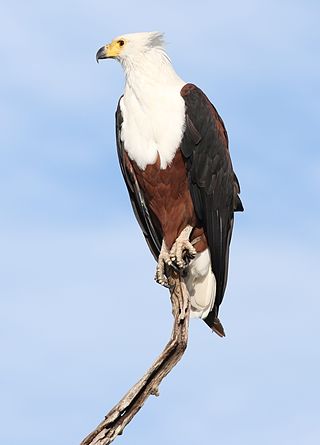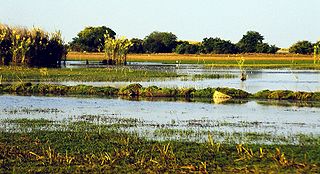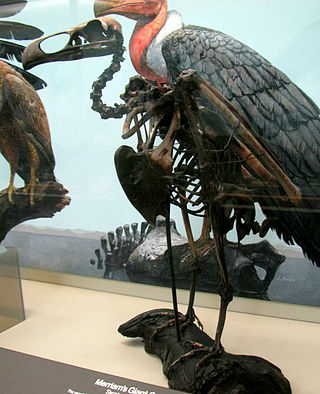
Storks are large, long-legged, long-necked wading birds with long, stout bills. They belong to the family Ciconiidae, and make up the order Ciconiiformes. Ciconiiformes previously included a number of other families, such as herons and ibises, but those families have been moved to other orders.

The hamerkop is a medium-sized wading bird. It is the only living species in the genus Scopus and the family Scopidae. The species and family was long thought to sit with the Ciconiiformes but is now placed with the Pelecaniformes, and its closest relatives are thought to be the pelicans and the shoebill. The shape of its head with a long bill and crest at the back is reminiscent of a hammer, which has given this species its name after the Afrikaans word for hammerhead. It is a medium-sized waterbird with brown plumage. It is found in Africa, Madagascar and Arabia, living in a wide variety of wetlands, including estuaries, lakesides, fish ponds, riverbanks, and rocky coasts. The hamerkop is a sedentary bird that often shows local movements.

The Pelecaniformes are an order of medium-sized and large waterbirds found worldwide. As traditionally—but erroneously—defined, they encompass all birds that have feet with all four toes webbed. Hence, they were formerly also known by such names as totipalmates or steganopodes. Most have a bare throat patch, and the nostrils have evolved into dysfunctional slits, forcing them to breathe through their mouths. They also have a pectinate nail on their longest toe. This is shaped like a comb and is used to brush out and separate their feathers. They feed on fish, squid, or similar marine life. Nesting is colonial, but individual birds are monogamous. The young are altricial, hatching from the egg helpless and naked in most. They lack a brood patch.

The shoebill, also known as the whale-headed stork, and shoe-billed stork, is a large long-legged wading bird. It derives its name from its enormous shoe-shaped bill. It has a somewhat stork-like overall form and has previously been classified with the storks in the order Ciconiiformes based on this morphology. However, genetic evidence places it with pelicans and herons in the Pelecaniformes. The adult is mainly grey while the juveniles are more brown. It lives in tropical East Africa in large swamps from South Sudan to Zambia.

The African fish eagle or the African sea eagle is a large species of eagle found throughout sub-Saharan Africa wherever large bodies of open water with an abundant food supply occur. It is the national bird of Malawi, Namibia, Zambia, and Zimbabwe. As a result of its large range, it is known in many languages. Examples of names include: Vis Arend in Afrikaans, nkwazi in Chewa, aigle pêcheur in French, hungwe in Shona, inkwazi in isiZulu, and ntšhu in Northern Sotho. This species may resemble the bald eagle in appearance; though related, the two species occur on different continents, with the bald eagle being resident in North America.

The Bangweulu Wetlands is a wetland ecosystem adjacent to Lake Bangweulu in north-eastern Zambia. The area has been designated as one of the world's most important wetlands by the Ramsar Convention and an "Important Bird Area" by BirdLife International. African Parks began managing Bangweulu in partnership with Zambia's Department of National Parks and Wildlife with the establishment of the Bangweulu Wetland Management Board in 2008.

Teratornithidae is an extinct family of very large birds of prey that lived in North and South America from the Late Oligocene to Late Pleistocene. They include some of the largest known flying birds. Its members are known as teratorns.

The Pelagornithidae, commonly called pelagornithids, pseudodontorns, bony-toothed birds, false-toothed birds or pseudotooth birds, are a prehistoric family of large seabirds. Their fossil remains have been found all over the world in rocks dating between the Early Paleocene and the Pliocene-Pleistocene boundary.

The African skimmer is a species of bird belonging to the skimmer genus Rynchops in the family Laridae. It is found along rivers, lakes and lagoons in Sub-Saharan Africa.

A water bird, alternatively waterbird or aquatic bird, is a bird that lives on or around water. In some definitions, the term water bird is especially applied to birds in freshwater ecosystems, although others make no distinction from seabirds that inhabit marine environments. Some water birds are more terrestrial while others are more aquatic, and their adaptations will vary depending on their environment. These adaptations include webbed feet, beaks, and legs adapted to feed in the water, and the ability to dive from the surface or the air to catch prey in water.

The Sahel bush sparrow or bush petronia, is a species of bird in the family Passeridae. It is found in Africa from Mauritania to Guinea and east to Eritrea and the south-western Arabian Peninsula in its natural habitats of dry savanna and subtropical or tropical dry shrubland.

The Phaethontiformes are an order of birds. They contain one extant family, the tropicbirds (Phaethontidae), and one extinct family Prophaethontidae from the early Cenozoic. Several fossil genera have been described, with well-preserved fossils known as early as the Paleocene. The group's origins may lie even earlier if the enigmatic waterbird Novacaesareala from the latest Cretaceous or earliest Paleocene of New Jersey is considered a tropicbird.
Eremopezus is a prehistoric bird genus, possibly a palaeognath. It is known only from the fossil remains of a single species, the huge and presumably flightless Eremopezus eocaenus. This was found in Upper Eocene Jebel Qatrani Formation deposits around the Qasr el Sagha escarpment, north of the Birket Qarun lake near Faiyum in Egypt. The rocks its fossils occur in were deposited in the Priabonian, with the oldest dating back to about 36 million years ago (Ma) and the youngest not less than about 33 Ma.

The order Suliformes is an order of birds recognised by the International Ornithologist's Union. Regarding the recent evidence that the traditional Pelecaniformes is polyphyletic, it has been suggested that the group be divided to reflect the true evolutionary relationships; a 2017 study indicated that they are most closely related to Otidiformes (bustards) and Ciconiiformes (storks).
Paludiavis is a genus of extinct waterbirds in the Balaenicipitidae family. It was described from fossil tarsometatarsus pieces, one found in the Upper Miocene series of the Shivalik Formation in northern Pakistan and the other, a 1972 find that is also from the Upper Miocence, of Tunisia, referred by Colin Harrison and Cyril Walker to the same genus. The genus consists of only one species, Paludavis richae.

Scopus is a genus of wading birds containing the hamerkop (Scopus umbretta) and its extinct Pliocene relative, Scopus xenopus. This genus is the sole representative of the family Scopidae.

Leptostomia is a genus of long-beaked pterosaur from the mid-Cretaceous (Cenomanian) of Morocco, North Africa. The type species is L. begaaensis, which was named and described in 2021 from sediments of the Kem Kem Group in Morocco. It was a small animal with a long, slender bill which is thought to have been used to probe sediments for worms and other invertebrates, similar to kiwi birds and curlews. Leptostomia is likely a member of the Azhdarchoidea.

Ardei is a possibly-paraphyletic suborder of order Pelecaniformes that include the families Ardeidae and Threskiornithidae. Traditionally the ardeids and threskiornithids were classified in the order Ciconiiformes along with Ciconiidae (storks), Phoenicopteridae (flamingos), Scopidae (hamerkop), Balaenicipitidae (shoebill), and even Cathartidae. However, there were some osteological studies that have questioned the monophyly of Ciconiiformes, suggesting that the ardeids and threskiornithids originated from early gruiforms, with the latter being a transitionary taxon to order Charadriiformes. The non-monophyletic nature of Ciconiiformes is supported by recent genomic studies that have found support for threskiornithids, ardeids, scopids and balaenicipitids being closely related to Pelecanidae (pelicans).

Birders in Canada and the United States refer to several families of long-legged wading birds in semi-aquatic ecosystems as waders. These include the families Phoenicopteridae (flamingos), Ciconiidae (storks), Threskiornithidae, Ardeidae, and the extralimital families Scopidae (hamerkop) and Balaenicipitidae (shoebill) of Africa. Elsewhere in the world, the word refers to what North Americans call a "shorebird", various families of the order Charadriiformes. In the past all of these families were classified in the order Ciconiiformes based on overall similarity in anatomy and ecology, as well as some molecular data. However recent genomic studies have found that this group to be polyphyletic, with flamingos being more closely related to grebes while ibises, herons, the hamerkop and the shoebill are more closely related to pelicans. As a result of these changes flamingos are placed in their own order Phoenicopteriformes and Ciconiiformes are solely restricted to the storks. The rest of the waders have been reclassified into the order Pelecaniformes.
Prophaethontidae is an extinct family of Early Paleogene phaethontiforms that include the genera Lithoptila and Prophaethon, as well as possibly Phaethusavis and Zhylgaia. The anatomy of the prophaethontids were more similar to those of members of the order Procellariiformes than to Phaethontidae, features including nostrils that are long and slit-like, with longer wings and legs. This suggests that prophaethontids were better at swimming and being more pelagic and surface-feeding than tropicbirds are today. Such features were suggested to link the phaethontiforms with the procellariiforms, but molecular studies do not support this and instead support a relationship between phaethontiforms and the order Eurypygiformes.
Kasoma, P. M. B., & Pomeroy, D. E. (1987). The Status and Ecology of Storks and the Shoebill in East Africa. Colonial Waterbirds, 10(2), 221–228. https://doi.org/10.2307/1521261
















